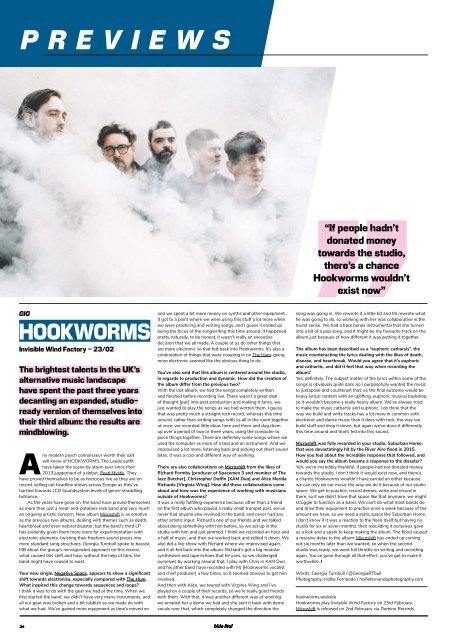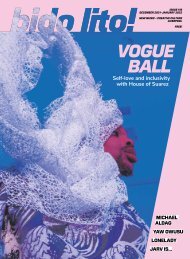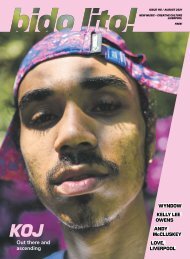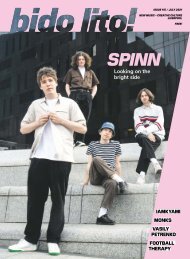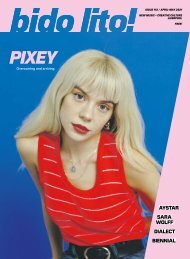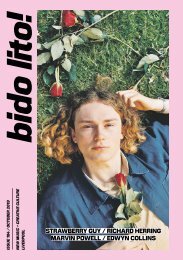Issue 85 / February 2018
February 2018 issue of Bido Lito! magazine. Featuring: RONGORONGO, MEHMET, NADINE SHAH, HOOKWORMS, WILLIAMSON ART GALLERY, DUDS and much more.
February 2018 issue of Bido Lito! magazine. Featuring: RONGORONGO, MEHMET, NADINE SHAH, HOOKWORMS, WILLIAMSON ART GALLERY, DUDS and much more.
Create successful ePaper yourself
Turn your PDF publications into a flip-book with our unique Google optimized e-Paper software.
PREVIEWS<br />
“If people hadn’t<br />
donated money<br />
towards the studio,<br />
there’s a chance<br />
Hookworms wouldn’t<br />
exist now”<br />
GIG<br />
HOOKWORMS<br />
Invisible Wind Factory – 23/02<br />
The brightest talents in the UK’s<br />
alternative music landscape<br />
have spent the past three years<br />
decanting an expanded, studioready<br />
version of themselves into<br />
their third album: the results are<br />
mindblowing.<br />
Any modern psych connoisseur worth their salt<br />
will know of HOOKWORMS. The Leeds outfit<br />
have taken the scene by storm ever since their<br />
2013 juggernaut of a debut, Pearl Mystic. They<br />
have proved themselves to be as ferocious live as they are on<br />
record, selling out headline shows across Europe as they’ve<br />
hurtled towards LCD Soundsystem levels of genre-straddling<br />
brilliance.<br />
As the years have gone on, the band have proved themselves<br />
as more than just a meat-and-potatoes rock band and very much<br />
an ongoing artistic concern. New album Microshift is as emotive<br />
as the previous two albums, dealing with themes such as death,<br />
heartbreak and even natural disaster; but the band’s third LP<br />
has evidently given them more room for experimentation with<br />
electronic elements, twisting their freeform sound pieces into<br />
more standard song structures. Georgia Turnbull spoke to bassist<br />
MB about the group’s reinvigorated approach on this record,<br />
what caused this shift and how, without the help of fans, the<br />
band might have ceased to exist.<br />
Your new single, Negative Space, appears to show a significant<br />
shift towards electronica, especially compared with The Hum.<br />
What inspired this change towards sequences and loops?<br />
I think it was to do with the gear we had at the time. When we<br />
first started the band, we didn’t have very many instruments, and<br />
all our gear was broken and a bit rubbish so we made do with<br />
what we had. We’ve gained more equipment as time’s moved on<br />
and we spent a bit more money on synths and other equipment.<br />
It got to a point where we were using this stuff a lot more when<br />
we were practicing and writing songs, and I guess it ended up<br />
being the focus of the songwriting this time around. It happened<br />
pretty naturally, to be honest, it wasn’t really an executive<br />
decision that we all made. A couple of us do other things that<br />
are more electronic so that fed back into Hookworms. It’s also a<br />
continuation of things that were creeping in on The Hum: going<br />
more electronic seemed like the obvious thing to do.<br />
You’ve also said that this album is centered around the studio,<br />
in regards to production and dynamic. How did the creation of<br />
the album differ from the previous two?<br />
With the last album, we had the songs completely written<br />
and finished before recording live. There wasn’t a great deal<br />
of thought [put] into post-production and making it fancy, we<br />
just wanted to play the songs as we had written them. I guess<br />
that was pretty much a straight rock record, whereas this time<br />
around, rather than writing songs with us all in the room together<br />
at once, we recorded little ideas here and there and dug them<br />
up over a period of two or three years, using the computer to<br />
piece things together. There are definitely some songs where we<br />
used the computer as more of a tool and an instrument. And we<br />
improvised a lot more, listening back and picking out short sound<br />
bites. It was a cool and different way of working.<br />
There are also collaborations on Microshift from the likes of<br />
Richard Formby [producer of Spacemen 3 and member of The<br />
Jazz Butcher], Christopher Duffin [XAM Duo] and Alice Merida<br />
Richards [Virginia Wing]. How did these collaborations come<br />
about and how was the experience of working with musicians<br />
outside of Hookworms?<br />
It was a really fulfilling experience because, other than a friend<br />
on the first album who played a really small trumpet part, we’ve<br />
never had anyone else involved in the band, and never had any<br />
other artistic input. Richard’s one of our friends and we talked<br />
about doing something with him before, so we set up in the<br />
studio with him and just jammed. I think we recorded an hour and<br />
a half of music, and then we worked back and edited it down. We<br />
also did a live show with Richard where we improvised again,<br />
and it all fed back into the album. Richard’s got a big modular<br />
synthesiser and tape echoes that he uses, so we challenged<br />
ourselves by working around that. I play with Chris in XAM Duo<br />
and his other band have recorded with MJ [Hookworms vocalist<br />
and chief producer] a few times, so it seemed obvious to get him<br />
involved.<br />
And then with Alice, we toured with Virginia Wing and I’ve<br />
played on a couple of their records, so we’re really good friends<br />
with them. With that, it was another different way of working:<br />
we emailed her a demo we had and she sent it back with demo<br />
vocals over that, which completely changed the direction the<br />
song was going in. We rewrote it a little bit and MJ rewrote what<br />
he was going to do, so working with her was collaborative in the<br />
truest sense. We had a bare bones instrumental that she turned<br />
into a bit of a pop song, and it might be my favourite track on the<br />
album just because of how different it was putting it together.<br />
The album has been described as a “euphoric catharsis”, the<br />
music counteracting the lyrics dealing with the likes of death,<br />
disease, and heartbreak. Would you agree that it’s euphoric<br />
and cathartic, and did it feel that way when recording the<br />
album?<br />
Yes, definitely. The subject matter of the lyrics within some of the<br />
songs is obviously quite dark, so I purposefully wanted the music<br />
to juxtapose and counteract that, so the final outcome would be<br />
heavy lyrical content with an uplifting, euphoric musical backdrop<br />
so it wouldn’t become a really heavy album. We’ve always tried<br />
to make the music cathartic and euphoric. I do think that the<br />
way we build and write tracks has a lot more in common with<br />
electronic and dance music than it does with rock, the way we<br />
build stuff and drop it down, but again we’ve done it differently<br />
this time around and that’s fed into this sound.<br />
Microshift was fully recorded in your studio, Suburban Home,<br />
that was devastatingly hit by the River Aire flood in 2015.<br />
How you feel about the incredible response that followed, and<br />
would you say the album became a response to the disaster?<br />
Yeh, we’re incredibly thankful. If people had not donated money<br />
towards the studio, I don’t think it would exist now, and there’s<br />
a chance Hookworms wouldn’t have carried on either because<br />
we can only do our music the way we do it because of our studio<br />
space. We get to practice, record demos, write and record in<br />
there, so if we didn’t have that space like that anymore, we might<br />
struggle to function as a band. We can’t do what most bands do<br />
and drive their equipment to practice once a week because of the<br />
amount we have, so we need a static space like Suburban Home.<br />
I don’t know if it was a reaction to the flood itself but having no<br />
studio for six or seven months, then rebuilding it ourselves gave<br />
us a kick and a spark to keep making the album. The flood caused<br />
a massive delay to the album: Microshift has ended up coming<br />
out six months later than we wanted, so when the second<br />
studio was ready, we went full throttle on writing and recording<br />
again. You’ve gone through all that effort, you’ve got to make it<br />
worthwhile. !<br />
Words: Georgia Turnbull / @GeorgiaRTbull<br />
Photography: Hollie Fernando / holliefernandophotography.com<br />
hookworms.website<br />
Hookworms play Invisible Wind Factory on 23rd <strong>February</strong>.<br />
Microshift is released on 2nd <strong>February</strong> via Domino Records.<br />
34


